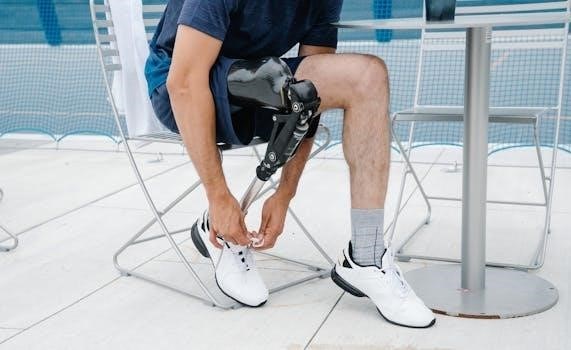owlet sock instructions
Setting up your Owlet Smart Sock involves several key steps, beginning with initial hardware configuration and app download. This guide provides a comprehensive overview, from unboxing to daily use. Ensure proper sock size is selected before use, and follow the app prompts carefully for optimal performance and accurate monitoring of your baby.
Initial Setup and Components
Before beginning the setup process, familiarize yourself with the contents of your Owlet Smart Sock box. The package includes the Dream Sock sensor, which comes pre-inserted in a small sock, a base station, charging cords, and an AC adapter. You will also find a quick start guide to assist with the initial setup steps. It is important to note that the sensor is initially placed in a small sock size; ensure that you verify the correct sock size for your baby before regular use. The sensor is equipped with a rechargeable battery that needs to be charged. The base station serves as the hub for communication, and it also charges the sensor. The Owlet Dream App is essential for completing the setup and monitoring your baby. Carefully inspect all components to ensure they are in good condition before proceeding. The quick start guide can provide a visual representation of what each component looks like.
Downloading the Owlet Dream App
The first step in setting up your Owlet Smart Sock is downloading the Owlet Dream App, which serves as the central interface for monitoring your baby. The app is available for both iOS and Android devices. To download the app, visit the App Store for iOS devices or the Google Play Store for Android devices, and search for “Owlet Dream App”. Ensure that you are downloading the official app by Owlet. Once you locate the app, initiate the download and installation process. It is important that your mobile device meets the minimum system requirements to ensure seamless functionality of the app. After the installation is complete, open the app. The app will guide you through the subsequent steps of creating an account, adding a child profile, and connecting the sock to the base station. Make sure your phone is connected to a stable Wi-Fi network during the download and setup process. The app provides a user-friendly interface to monitor your baby’s vitals, receive notifications, and customize settings for your device.
Creating an Owlet Account
After successfully downloading the Owlet Dream App, the next crucial step is creating an Owlet account. This account will securely store your baby’s data and allow you to access the monitoring features. Open the app and select the ‘Join’ or ‘Create Account’ option, typically located on the initial screen. You will be prompted to enter your email address and create a secure password. Ensure you use a valid email address as it will be used for account verification and notifications. Follow the on-screen instructions to complete the registration process. You might be asked to agree to Owlet’s terms of service and privacy policy. It’s important to review these documents carefully before proceeding. Once your account is created, you may be asked to verify your email address through a link sent to your inbox. This is a necessary step to activate your account fully. After verification, you can log in and proceed with setting up your device and adding a child profile, which will personalize the monitoring experience.
Adding a Child Profile
Once your Owlet account is successfully created and you are logged into the app, the next essential step is to add a child profile. This profile is where all of the data related to your baby’s monitoring will be stored. Within the Owlet Dream App, navigate to the settings or profile section, where you’ll find an option to ‘Add a Child’ or similar. You’ll be prompted to enter key information about your child, such as their name, date of birth, and gender. This information helps personalize the experience and ensures accurate data tracking. You might also have the option to add a profile photo for easy identification. Follow the on-screen prompts carefully, ensuring all details are correct. Once you have filled in all the required information, save the profile. You may be able to add more than one child profile if you have multiple children using the Owlet system. Each child profile will have unique monitoring data associated with it. This step is critical to ensure data is tracked and presented correctly, and it allows you to switch between profiles seamlessly if needed.

Connecting the Sock to the Base Station
After setting up your child’s profile, the next step is to connect the Owlet Smart Sock to the base station. This establishes the crucial link for monitoring data transmission. Locate the sensor within the small sock provided in the packaging. Ensure it’s properly inserted and secured. Then, take the sock with the sensor and gently place it onto the designated charging port on the base station. You should feel a small magnetic connection when it’s properly aligned. This connection not only charges the sensor but also establishes the communication link. Once connected, the base station will indicate a successful connection through a visual cue, such as a light turning on or flashing. Check the Owlet app for confirmation that the sock and base station are linked and that the sensor is charging. It’s important to make sure the sock is properly seated on the base station to ensure uninterrupted monitoring. If a connection is not established, try re-aligning the sock on the base station again. This connection will ensure that the sensor is charged and ready for use, as well as enabling data transmission to the base station and the app.
Plugging in the Base Station

With the sensor connected to the base station, the next crucial step involves powering up the base station by plugging it into a reliable power source. Locate the AC adapter included in your Owlet Smart Sock package. Connect the provided USB cable to the adapter and then plug the other end of the cable into the designated port on the back of the base station. Once the cable is properly connected, plug the adapter into a standard wall outlet. Ensure the outlet is functioning correctly. Upon successfully plugging in the base station, you should see an indicator light illuminate. This confirms that the base station is receiving power. The light will typically be located on the base station itself. It’s important to place the base station in a location where it has a clear view of the sock and is within the recommended Wi-Fi range to ensure consistent and accurate data transmission. Make sure the power outlet you use is easily accessible and not obstructed. A stable power supply is essential for the base station’s consistent performance.
Wi-Fi Connectivity
Establishing a stable Wi-Fi connection is essential for your Owlet Smart Sock to function correctly, allowing seamless data transmission to your mobile app. The Owlet base station requires a 2.4 GHz Wi-Fi network; it is not compatible with 5 GHz networks or hotspot connections. During the setup process, the Owlet app will prompt you to select your home’s Wi-Fi network from the available list. Ensure your Wi-Fi network is active and that you have the correct password readily available before initiating this step. Enter your Wi-Fi password when prompted by the app. Once entered correctly, the base station will attempt to connect to the selected network. A successful connection is usually indicated by a solid light on the base station. If the connection fails, double-check the password for accuracy. If problems persist, move the base station closer to your router, and ensure the network is stable. This connection is vital for real-time data and monitoring updates.

Troubleshooting Wi-Fi Connection Issues
If you encounter difficulties connecting your Owlet base station to Wi-Fi, several steps can help resolve the issue. First, confirm that your Wi-Fi network is a 2.4 GHz network, as the Owlet is not compatible with 5 GHz. Make sure the Wi-Fi password was entered correctly. Restart your router and the Owlet base station, as this often resolves temporary connectivity problems. Move the base station closer to your router to ensure a strong signal. If the issue continues, verify that your router’s firmware is up to date. Temporarily disable any firewalls or VPNs that could be interfering with the connection. Double-check that there are no obstructions blocking the Wi-Fi signal. If connecting via a mesh network, try connecting directly to the main router. If these troubleshooting steps fail, consult the Owlet support documentation or contact their customer service for further assistance. Remember that stable Wi-Fi is essential for continuous monitoring.
Sock Size Selection
Selecting the correct sock size for your Owlet Smart Sock is critical for accurate readings and comfortable wear. The sensor usually comes inserted in a small-sized sock; however, it’s crucial to verify the size before actual use. The Owlet typically includes multiple sock sizes to accommodate different stages of growth. Using the wrong size can lead to inaccurate data and discomfort for your baby. Refer to the Owlet app or user manual for specific sizing guidelines based on your child’s foot measurements. Ensure the sock fits snugly but not too tightly, allowing proper circulation. It should sit securely on the foot without slipping. If you’re unsure, it’s better to err on the side of a slightly looser fit, provided that the sensor maintains good contact with the skin. Regularly check the fit as your baby grows, and transition to a larger size when necessary to continue reliable monitoring. A properly sized sock ensures the sensor is positioned correctly;
Charging the Sensor
The Owlet Smart Sock sensor requires regular charging to ensure continuous monitoring. The sensor contains a rechargeable battery that needs to be fully charged before its first use. To charge the sensor, connect it to the base station using the provided charging cord. The base station should be plugged into a power outlet using the AC adapter. A light indicator on the base station will typically show when the sensor is charging and when it’s fully charged. Make sure the connection is secure to avoid interruptions in charging. It’s best to charge the sensor when it’s not in use, such as during naps or bedtime, to maintain consistent monitoring. Allow sufficient time to charge the sensor fully to maximize its battery life. Avoid using the sensor while it is charging, as this may affect the charging process. Periodically check the sensor’s battery level using the app. A fully charged sensor ensures reliable data collection and peace of mind for parents. Always use the original charging components for safety and optimal performance.
Using Multiple Owlet Units
Managing multiple Owlet units, such as for twins or multiple children, requires a systematic approach to avoid confusion and ensure proper monitoring. Each Owlet unit, consisting of a sock sensor and a base station, should be set up and registered individually within the Owlet app. Do not attempt to set up multiple units simultaneously; instead, complete the setup process for one unit fully before proceeding to the next. This helps to prevent interference and ensures accurate registration of each device. The app allows you to create separate child profiles, so you can assign each sock to the correct child. Name each base station within the app to easily identify which child it belongs to. It’s essential to keep each unit’s components separate and associated with its designated child. Charging and storing each sensor and base should be done separately to avoid accidental mixing. This approach ensures each child receives the individual monitoring they need, providing reliable data and peace of mind for caregivers. Maintain a system for tracking each unit’s usage and charging schedule.
Compatibility and Limitations
The Owlet Smart Sock, while a powerful monitoring tool, has specific compatibility requirements and limitations users should be aware of. The device primarily functions with the dedicated Owlet app, available on both iOS and Android platforms. It is crucial to ensure your mobile device meets the minimum operating system requirements for optimal app performance. The Owlet system relies on a 2.4 GHz Wi-Fi network connection; it does not support 5 GHz networks or hotspot Wi-Fi, which may limit connectivity in some environments. Additionally, the Owlet sock is designed for specific age and weight ranges, with sock sizes tailored to infants, making it unsuitable for older children or adults. Furthermore, the device is not intended to be a medical device and should not replace professional medical advice or care. The Owlet is designed to monitor a baby’s data, but it has its limitations. It is essential to understand these limitations and use the device responsibly, always prioritizing safety and consulting with healthcare providers for any concerns.
